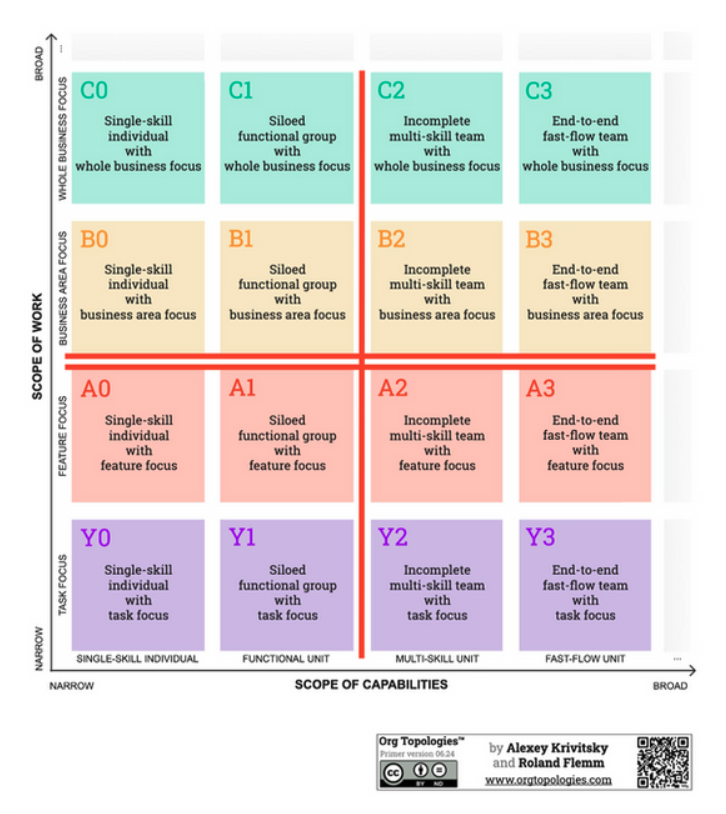
Org Topologies™ and Doing Better Scrum
Last month, I did something a bit unusual. Instead of being the instructor, I was a student and attended an Org Topologies™ Practitioner course. The things I learned there resonated with me because they helped me answer this question, “Why do so many organizations struggle to #DoBetterScrum?”
When done well, Scrum (and other Agile processes) will create change. But many Scrum and Agile adoptions are short-lived or superficial. They do not touch upon the other elements of organizational design – strategy, structure, rewards and people. IME, if you do not adjust these other elements of the system, the organizational design will reject the new processes because they are inconsistent with how the business truly operates. For me, the Org Topologies course gave me a light that I can shine onto an organizational design to discover if it is fit for purpose.
What is Org Topologies?
Org Topologies is a mental model published by Alexey Krivitsky and Roland Flemm to help organizations visualize how their teams are organized. The model is based upon a series of archetypes (Y0, A1, B2, etc.) organized around two axes. The overall goal is to map the various teams within the organization into the different archetypes so that the business can then draw conclusions about the effectiveness of its organizational design to realize its strategic business objectives.
 The x-direction measures the delivery capability of each individual unit in the organization. It describes the ability of each unit to sustain fast flow of complete units of value to the customer. On the left side of the x-axis, zero and one, the work is predominantly functional. Specialists, or groups of specialists, focus
The x-direction measures the delivery capability of each individual unit in the organization. It describes the ability of each unit to sustain fast flow of complete units of value to the customer. On the left side of the x-axis, zero and one, the work is predominantly functional. Specialists, or groups of specialists, focus
on completing a single part of the whole. On the right side of the x-axis, two and three, the work is multifunctional. In this case, cross-functional teams must collaborate to deliver a complete slice of customer value.
The y-direction measures the scope of the work of each unit in the organization. It describes the level of knowledge each unit has about the customer and the degree of co-ownership of the business outcomes among the various work units. At the lower levels, Y and A, the scope is narrow. Individual tasks or small features that are often disconnected from customers and\or business outcomes. At the higher levels, B and C, the scope expands to include outcomes that have a broader impact to the business.
How is Success Defined with Org Topologies?
In their model, Krivitsky and Flemm place the highest performing units in a location they call “C3”. When a small business is operating as a start-up, it would be considered a C3 unit. A C3 unit has the following characteristics:
- It is a cross-functional team that can deliver a complete slice of value to its customers quickly and efficiently, with a minimal amount of waste.
- The team has direct interaction with customers and is adaptive to a changing business environment.
- As a result of its direct interaction with both customers and the competitive landscape, the team will learn whatever is needed in order to generate a win for both the customer and the business.
As the business scales, the various responsibilities that were contained within the initial C3 unit, the start-up, are now divided across multiple units that map to lower archetypes, such as Y0, Y3, A0 or A1. Unfortunately, the lower archetype work units lack self-sufficiency, so they need coordinating units from the higher archetypes to deliver end-to-end value to the customer. By definition, the entire organization must be C3 or it would fail as a business.
How Does Org Topologies Help You #DoBetterScrum?
There are a couple of reasons why I think this mental model will be helpful for teams and organizations who want to do better Scrum.
- Evolutionary: with its scales of zero to three and Y to C, practitioners and other leaders can chart their growth along multiple horizons based upon the destination they desire.
- Diagnostic: it helps practitioners and other leaders identify where they are today, where they can expect to encounter resistance, from whom and offers some reasons why they might be resisting change.
- Holistic: to achieve higher levels of performance, practitioners and business leaders must look beyond the adoption of new (Agile) processes and consider additional elevating practices that impact strategy, structure, rewards and people.
What I like about this model is that its creators are (mostly) neutral on what is the final destination. While both have a preference to help organizations to grow in the direction of C3, one of their main motivations was to publish a model that gave practitioners a clear and specific language when talking about organizational design.
For instance, if a business completes an Org Topologies mapping and discovers its current organizational design enables it to achieve its strategic objectives, then nothing needs to be changed. However, if the mapping reveals the organizational design is not fit for purpose, there are a number of elevating structures they could adopt to shift right, or up, in the Org Topologies map.





